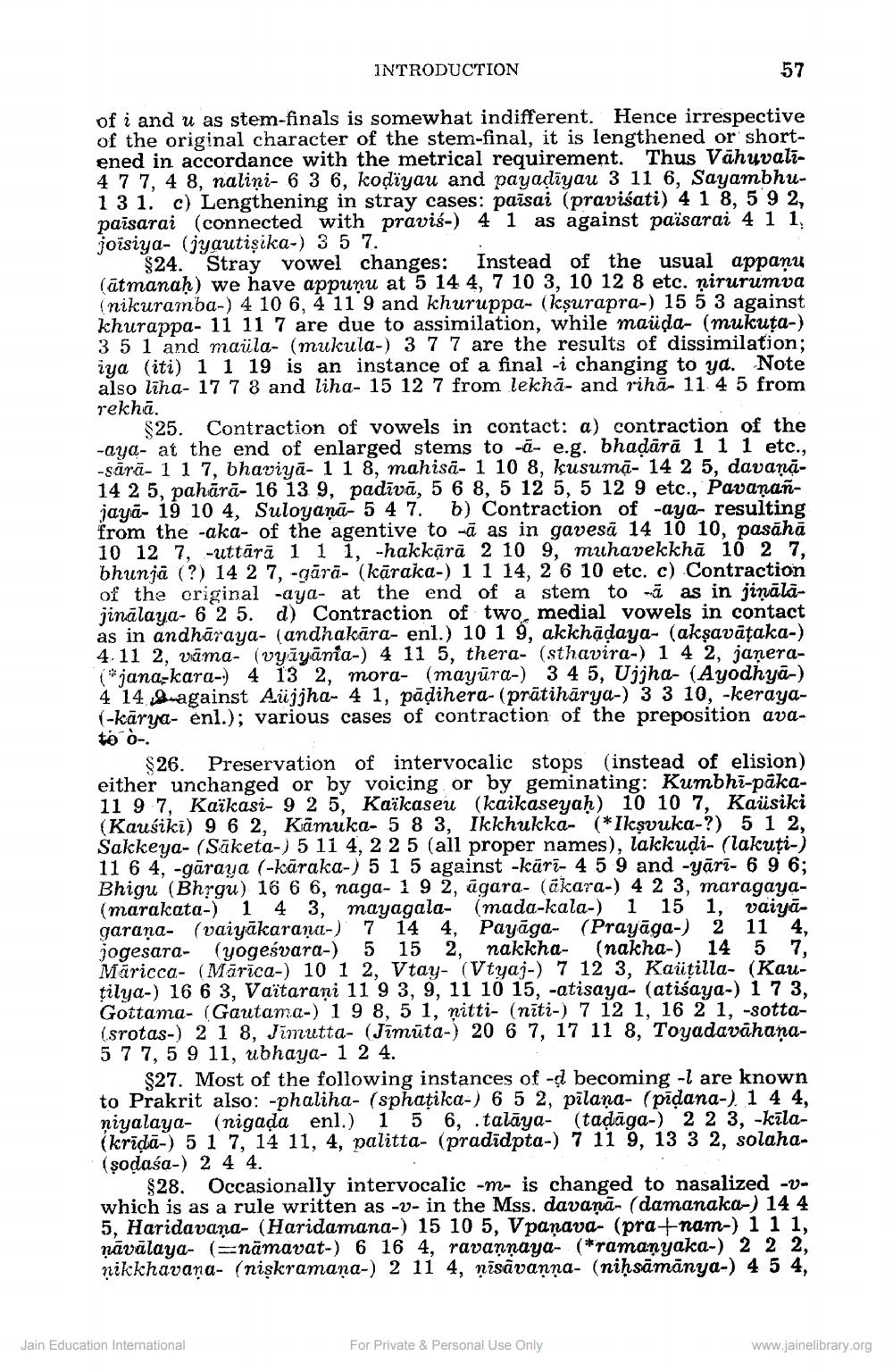________________
INTRODUCTION
57
of i and u as stem-finals is somewhat indifferent. Hence irrespective of the original character of the stem-final, it is lengthened or shortened in accordance with the metrical requirement. Thus Vähyvali4 7 7, 4 8, nalini- 6 36, kodżyau and payadiyau 3 11 6, Sayambhu131. c) Lengthening in stray cases: paisai (pravisati) 4 1 8,5 92, paisarai (connected with pravis-) 4 1 as against païsarai 4 1 1,
paīsarai Ayautişika-) ve changes: 4 4,7 10 3, 10 apra-) 15 5 3 a kuta-) joisiyoz 4. stray ve appunu and khuruption, while mot dissimila Note
$24. Stray vowel changes: Instead of the usual appaņu (ātmanah) we have appunu at 5 14 4, 7 10 3, 10 12 8 etc. nirurumva (nikuramba-) 4 10 6, 4 11 9 and khuruppa- (kșurapra-) 15 5 3 against khurappa- 11 11 7 are due to assimilation, while maüda- (mukuta-) 3 5 1 and maüla- (mukula-) 3 7 7 are the results of dissimilation; iya (iti) 1 1 19 is an instance of a final -i changing to yd. Note also līna- 17 7 8 and liha- 15 12 7 from lekhā- and riha- 11 4 5 from rekhā.
$25. Contraction of vowels in contact: a) contraction of the -aya- at the end of enlarged stems to -ā- e.g. bhadārā 1 1 1 etc., -sarā-11 7, bhaviyā- 1 1 8, mahisa- 1 10 8, kusumā- 14 2 5, davaņa14 2 5, pahárā- 16 13 9, padīvā, 5 6 8, 5 12 5, 5 12 9 etc., Pavananjaya- 19 10 4, Suloyaņā- 5 4 7. b) Contraction of -aya- resulting from the -aka- of the agentive to -ā as in gavesā 14 10 10, pasāhā 10 12 7, -uttară 1 1 i, -hakkarā 2 10 9, muhavekkhā 10 27, bhunjā (?) 14 2 7, -gārā- (kāraka-) 11 14, 2 6 10 etc. c) Contraction of the criginal -aya- at the end of a stem to cū as in jinālajinālaya- 6 2 5. d) Contraction of two, medial vowels in contact as in andhāraya- (andhakāra- enl.) 10 1 9, akkhādaya- (akşavāțaka-) 4.11 2, vama- (vyāyānia-) 4 11 5, thera- (sthavira-) 1 4 2, jaņera(jana-kara-) 4 13 2, mora- (mayūra-) 3 4 5, Ujjha- (Ayodhyā-) 4 14 against Aujjha- 4 1, pādihera- (prätihārya-) 3 3 10, -keraya(-kārya- enl.); various cases of contraction of the preposition avato o
$26. Preservation of intervocalic stops (instead of elision) either unchanged or by voicing or by geminating: Kumbhi-paka11 97, Kaïkasi- 9 2 5, Kažkaseu (kaikaseyah) 10 10 7, Kaüsiki (Kausiki) 9 6 2, Kamuka- 5 8 3, Ikkhukka- (*Ikşvuka-?) 51 2, Sakkeya- (Säketa-) 5 11 4,2 2 5 (all proper names), lakkudi- (lakuți-) 11 6 4. -gāraua (-kāraka-) 5 1 5 against -käri- 4 5 9 and -yāri- 6 96; Bhigu (Bhrgu) 16 6 6, naga-192, agara- (akara-) 4 2 3, maragaya(marakata-) 1 4 3, mayagala- (mada-kala-) 1 15 1, vaiyagaraņa- (vaiyakarana-) 7 14 4, Payāga- (Prayāga-) 2 11 4, jogesara (yogeśvara-) 5 15 2, nakkha. (nakha-) 14 5 7. Maricca- (Marica-) 10 1 2, Vtay- (Vtya;-) 7 12 3, Kaütilla- (Kautilya-) 16 6 3, Važtarani 11 93, 9, 11 10 15, -atisaya- (atiśaya-) 1 7 3, Gottama- (Gautama-) 1 9 8, 51, nitti- (nīti-) 7 12 1, 16 2 1, -sotta(srotas-) 2 1 8, Jimutta- (Jimūta-) 20 67, 17 11 8, Toyadavāhana5 7 7,5 9 11, ubhaya- 1 2 4.
$27. Most of the following instances of -d becoming -l are known to Prakrit also: -phaliha- (sphatika-) 6 5 2, pilana- (pādana-). 1 4 4, niyalaya (nigada enl.) 1 5 6, .talāya- (tadäga-) 2 2 3, -kala(krīdā-) 5 1 7, 14 11, 4, palitta- (pradidpta-) 7 11 9, 13 3 2, solaha(sodaśa-) 2 4 4.
$28. Occasionally intervocalic -m- is changed to nasalized -- which is as a rule written as -1- in the Mss, davanā- (damanaka-) 14 4 5, Haridavana- (Haridamana-) 15 10 5, V panava- (pra+nam-) 11 1, nāvālaya- (=nāmavat-) 6 16 4, ravaņņaya- (*ramanyaka-) 2 2 2, nikkhavaņa- (niskramana-) 2 11 4, ņēsāvanna- (niņsāmānya-) 4 5 4,
Jain Education International
For Private & Personal Use Only
www.jainelibrary.org




